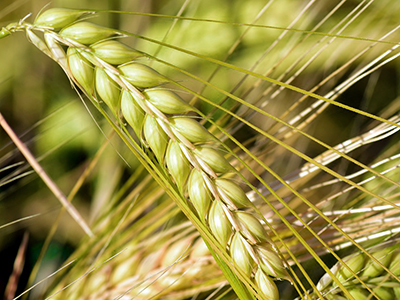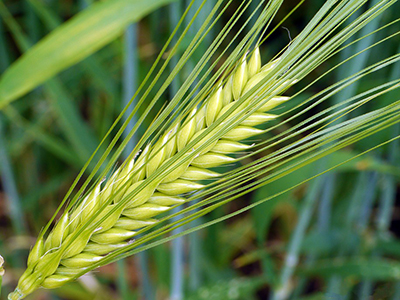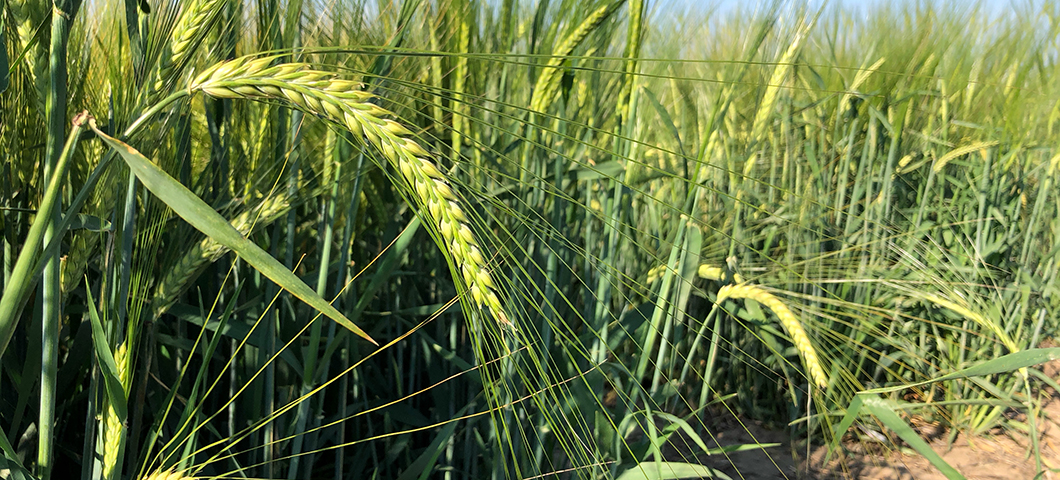2-Row vs 6-Row
By Hannah Turner
Published: Montana Craft Beer Connect
The terminology two-row vs. six-row is derived from the physical morphology of two different types of barley. A single gene out of roughly 30,000 in barley causes the development of either two or six kernels consecutively along the barleys head. Both types have alternating sets of three spikelets,, however in two-row barleys only the central spikelets are fertile and develop seed creating a flat shaped head. Six-row types have a rounded head appearance with all six kernels developing. The tightly packed seeds around the six-row head tend to be smaller (less starch/more husk) and more variable in size – both less desirable traits as they lead to inconsistent malting and less overall extract. The smaller six-row kernels also have relatively more protein as protein and starch are inversely balanced. In the malting process protein is broken down in varying extent to its individual building blocks, amino acids. Amino acids such as these form into the enzymes necessary for grain modification during malting and starch conversion later in brewing. Therefore six-row’s higher protein favors higher potential for enzymatic activity. This difference lends itself to the popularity of six-row barleys among the large brewers of North America as the boost in enzymes allows for conversion of mashes which are heavy in adjuncts such as rice and corn, grains relatively low in enzymes.
Most countries outside of North America exclusively use two-row barley for malt (six-row, if produced, is used for feed), but six-row varieties have played an important role in US brewing. Barley was first introduced by European colonists in the early 1600s who quickly found that six-row types were better suited to the new world climate. With the pass of time barley production has been pushed west cut to displacement by disease pressures and increased production of other major crops such as corn and soybean. Relatively higher yields than two-row and high demand from the big brewers kept six-row as the dominant barely type as late as the ‘90s. Today that has changed and according to surveys conducted by the American Malting Barley Association (AMBA) about 85% of reported acreage was planted with two-row in 2018. Breeding efforts minimizing differences between the barley types and the western climate, which is well suited to two-row, has brought this shift about. Currently North Dakota and Minnesota are the main producers of six-row, while the largest production states, Montana and Idaho, plant very little six-row. Breeding efforts primarily focus on improvement of two-row varieties, and in fact AMBA, which publishes guidelines for breeding based on end usage, no longer provides recommendations for six-row. This is matched by AMBAs 2019 list of recommended varieties which includes more than 25 two-row types but only 7 six-row options. With Craft Malting growing however, diverse areas of the country are seeing interest in locally grown grains despite lack of local breeding efforts to provide well adapted options. This has led to small pockets growing variable varieties including six-row types.
Although you may not see a lot of six-row malts in Montana, the things to look out for as a brewer when considering this ingredient are the enzymatic and extract differences, higher soluble protein potentially leading to brewing issues, flavor variation, and possibly mill adjustments for the smaller grains. As malting progresses approximately 38-45% of the grains protein is converted to wort-soluble protein. The components of soluble protein are important for beer foam, mouthfeel, beer color and flavor, and yeast metabolism. However if there is too much (exceeding ~5.5% in the wort) problems can arise such as too much color development during wort boiling, filtration issues, and risk of haze formation. The higher protein makes six-rows popular for specialty malts as the amino-acids making up the protein are an important aspect of the Maillard reactions that produce color and flavor. Additionally the greater husk content of six-row leads to varied flavor profiles such as higher phenolics potentially contributing astringent flavor. It is unlikely that a brewer would choose to make an all-malt beer with exclusively six-row barley due to high protein and enzyme content, however supplementing a small portion could be useful depending on the profile of your primary base malt and if using other ingredients like un-malted or alternative grains.
 |
 |
| Two-Row Barley | Six-Row Barley |

